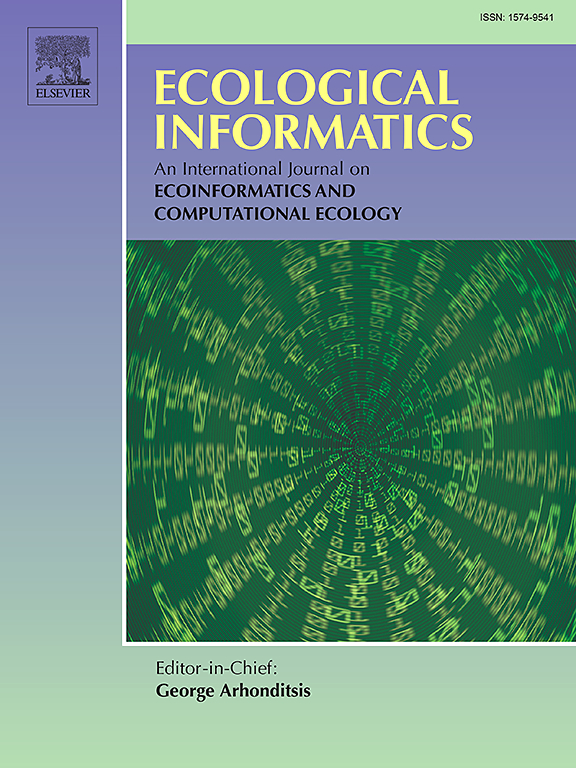快速贪婪算法揭示了南太平洋城市鲨鱼群落的小时波动和相关风险
IF 7.3
2区 环境科学与生态学
Q1 ECOLOGY
引用次数: 0
摘要
在全球范围内,鲨鱼无端咬人的现象正在增加。努姆萨玛等地区热点地区显示,涉及牛鲨(Carcharhinus leucas)和虎鲨(Galeocerdo cuvier)的事件越来越多,导致这些受保护物种被淘汰。确定高风险区域和时间是平衡人类安全和鲨鱼保护的关键。在这里,我们收集了五年的声学遥测数据,这些数据来自于努姆萨伊泻湖的两种鲨鱼。数据按物种分类,分成24小时子集,建立二部图模型。快速贪婪算法被应用于识别不同的鲨鱼群落和站点。利用归一化互信息对群落进行聚类并检测时空模式。研究显示,牛鲨每小时有9个群落,虎鲨每小时有21个群落,每个群落分为3个群体。确定了几个高风险地区和时间。牛鲨成群结队,在6:00至13:00之间在港口观察到一群牛鲨,增加了早上附近海滩的咬伤风险。虎鲨比较孤独,除了相对浑浊的区域外,在大多数站点日夜出没。这两个物种都表现出了裂变融合的动态,群落在黄昏时合并,表明在这个光线不足的时期活动增加,风险更高。我们的建模框架的一个关键创新是它能够处理应用于二部网络的社区检测算法的时间变异性。该模型确定了鲨鱼与人类活动的关键重叠期,强调了实时监测、安全措施和公众意识的必要性,以减少咬伤风险,促进共存。本文章由计算机程序翻译,如有差异,请以英文原文为准。

The Fast-Greedy algorithm reveals hourly fluctuations and associated risks of shark communities in a South Pacific city
Unprovoked shark bites are increasing globally. Regional hotspots like Nouméa show rising incidents involving bull sharks (Carcharhinus leucas) and tiger sharks (Galeocerdo cuvier), leading to the culling of these protected species. Identifying high-risk areas and times is key to balancing human safety and shark conservation. Here, we collected five years of acoustic telemetry data for both shark species in the lagoon of Nouméa. The data were categorized by species, divided into 24 hourly subsets, and modeled as bipartite graphs. The Fast-Greedy algorithm was applied to identify distinct communities of sharks and stations. Normalized mutual information was used to cluster communities and detect spatiotemporal patterns. The study revealed up to 9 hourly communities for bull sharks and 21 for tiger sharks, each grouping into 3 clusters. Several high-risk areas and times were identified. Bull sharks formed schools, and a cluster was observed in the harbor between 6:00 and 13:00, increasing bite risk on nearby beaches in the morning. Tiger sharks were more solitary and were present day and night at most stations except those in relatively turbid areas. Both species showed fission–fusion dynamics, with communities merging at dusk, indicating increased movement and a higher risk during this low-light period. A key innovation of our modeling framework was its ability to handle temporal variability in community detection algorithms applied to bipartite networks. The model identified key overlap periods of shark–human activity, highlighting the need for real-time monitoring, safety measures, and public awareness to reduce bite risk and promote coexistence.
求助全文
通过发布文献求助,成功后即可免费获取论文全文。
去求助
来源期刊

Ecological Informatics
环境科学-生态学
CiteScore
8.30
自引率
11.80%
发文量
346
审稿时长
46 days
期刊介绍:
The journal Ecological Informatics is devoted to the publication of high quality, peer-reviewed articles on all aspects of computational ecology, data science and biogeography. The scope of the journal takes into account the data-intensive nature of ecology, the growing capacity of information technology to access, harness and leverage complex data as well as the critical need for informing sustainable management in view of global environmental and climate change.
The nature of the journal is interdisciplinary at the crossover between ecology and informatics. It focuses on novel concepts and techniques for image- and genome-based monitoring and interpretation, sensor- and multimedia-based data acquisition, internet-based data archiving and sharing, data assimilation, modelling and prediction of ecological data.
 求助内容:
求助内容: 应助结果提醒方式:
应助结果提醒方式:


